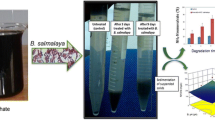Abstract
Struvite biomineralization is a promising method for phosphorus recovery from wastewater treatment plant streams, and the growth of responsible microorganisms in mixed cultures is one of the most critical points for applying this process in pilot and full-scale. This study aimed to investigate the growth and bio-struvite production of Brevibacterium antiquum in mixed sludge culture. Alkaline fermentation was applied at different pH conditions to enhance the phosphorus content of sludge for an efficient recovery, and pH 8 was determined as the most feasible considering the phosphorus release and sludge characteristics. Growth optimization studies showed that NaCl's presence decreases the growth rate of Brevibacterium antiquum and bio-struvite production. At the same time, pH in the range of 6.8–8.2 did not alter the growth significantly. In addition, studies showed the ability of Brevibacterium antiquum in unsterilized fermented sludge centrate to grow and recover the phosphorus as struvite. Thus, our results indicated the potential of struvite biomineralization in full-scale wastewater treatment plants.




Similar content being viewed by others
Data availability
Data will be available on request: sevil.cn@gmail.com.
Abbreviations
- TP:
-
Total phosphorus
- COD:
-
Chemical oxygen demand
- MLVSS:
-
Mixed liquor volatile suspended solids
- MLSS:
-
Mixed liquor suspended solids
- VFA:
-
Volatile fatty acid
- OD:
-
Optical density
- FT-IR:
-
Fourier-transform infrared spectroscopy
- SEM–EDS:
-
Scanning electron microscopy with energy dispersive spectroscopy
- AP:
-
Apatite phosphorus
- NAIP:
-
Non-apatite inorganic phosphorus
- AHP:
-
Acid-hydrolyzable phosphorus
- Org-P:
-
Organic
References
American Public Health A, Eaton AD, American Water Works A, Water Environment F (2005) Standard methods for the examination of water and wastewater. APHA-AWWA-WEF, Washington, DC
Beye M, Bakour S, Traore SI, Rathored J, Labas N, Raoult D, Fournier P-E (2018) Draft genome sequence of Fermentimonas caenicola strain SIT8, isolated from the human gut. Stand Genomic Sci 13(1):8. https://doi.org/10.1186/s40793-018-0310-6
Carr EL, Kämpfer P, Patel BKC, Gürtler V, Seviour RJ (2003) Seven novel species of Acinetobacter isolated from activated sludge. Int J Syst Evol Microbiol 53(Pt 4):953–963. https://doi.org/10.1099/ijs.0.02486-0
Chen Y, Jiang S, Yuan H, Zhou Q, Gu G (2007) Hydrolysis and acidification of waste activated sludge at different pHs. Water Res 41(3):683–689. https://doi.org/10.1016/j.watres.2006.07.030
Chen Y, Feng Y, Deveaux JG, Masoud MA, Chandra FS, Chen H, Zhang D, Feng L (2019a) Biomineralization forming process and bio-inspired nanomaterials for biomedical application: a review. Minerals 9(2):68
Chen Y, Lin H, Shen N, Yan W, Wang J, Wang G (2019b) Phosphorus release and recovery from Fe-enhanced primary sedimentation sludge via alkaline fermentation. Biores Technol 278:266–271. https://doi.org/10.1016/j.biortech.2019.01.094
Chen Y, Ruhyadi R, Huang J, Yan W, Wang G, Shen N, Hanggoro W (2021) Comprehensive comparison of acidic and alkaline anaerobic fermentations of waste activated sludge. Biores Technol 323:124613. https://doi.org/10.1016/j.biortech.2020.124613
Gavrish EY, Krauzova VI, Potekhina NV, Karasev SG, Plotnikova EG, Altyntseva OV, Korosteleva LA, Evtushenko LI (2004) Three new species of Brevibacteria, Brevibacterium antiquum sp. nov., Brevibacterium aurantiacum sp. nov., and Brevibacterium permense sp. nov. Microbiology 73(2):176–183. https://doi.org/10.1023/B:MICI.0000023986.52066.1e
González JM, Fernández-Gómez B, Fernàndez-Guerra A, Gómez-Consarnau L, Sánchez O, Coll-Lladó M, Del Campo J, Escudero L, Rodríguez-Martínez R, Alonso-Sáez L, Latasa M, Paulsen I, Nedashkovskaya O, Lekunberri I, Pinhassi J, Pedrós-Alió C (2008) Genome analysis of the proteorhodopsin-containing marine bacterium Polaribacter sp. MED152 (Flavobacteria). Proc Natl Acad Sci USA 105(25):8724–8729. https://doi.org/10.1073/pnas.0712027105
Grover JE, Rope AF, Kaneshiro ES (1997) The occurrence of biogenic calcian struvite, (Mg, Ca)NH4PO4.6H2O, as intracellular crystals in paramecium. J Eukaryotic Microbiol 44(4):366–373. https://doi.org/10.1111/j.1550-7408.1997.tb05679.x
Harms C, Schleicher A, Collins MD, Andreesen JR (1998) Tissierella creatinophila sp. nov., a gram-positive, anaerobic, non-spore-forming, creatinine-fermenting organism. Int J Syst Bacteriol 48(3):983–993. https://doi.org/10.1099/00207713-48-3-983
He ZW, Liu WZ, Wang L, Tang CC, Guo ZC, Yang CX, Wang AJ (2016) Clarification of phosphorus fractions and phosphorus release enhancement mechanism related to pH during waste activated sludge treatment. Bioresour Technol 222:217–225. https://doi.org/10.1016/j.biortech.2016.10.010
Hu P, Liu J, Wu L, Zou L, Li YY, Xu ZP (2019) Simultaneous release of polyphosphate and iron-phosphate from waste activated sludge by anaerobic fermentation combined with sulfate reduction. Bioresour Technol 271:182–189. https://doi.org/10.1016/j.biortech.2018.09.117
Hyun D-W, Oh SJ, Kim M-S, Whon TW, Jung M-J, Shin N-R, Kim PS, Kim HS, Lee J-Y, Kang W, Bae J-W (2015) Simplicispira piscis sp. nov., isolated from the gut of a Korean rockfish, Sebastes schlegelii. Int J Syst Evol Microbiol 65(12):4689–4694. https://doi.org/10.1099/ijsem.0.000635
Jabari L, Gannoun H, Cayol JL, Hedi A, Sakamoto M, Falsen E, Ohkuma M, Hamdi M, Fauque G, Ollivier B, Fardeau ML (2012) Macellibacteroides fermentans gen. nov., sp. Nov., a member of the family Porphyromonadaceae isolated from an upflow anaerobic filter treating abattoir wastewaters. Int J Syst Evol Microbiol 62(10):2522–2527. https://doi.org/10.1099/ijs.0.032508-0
Kim H-S, Bang JJ, Lee S-S (2017) Gelidibacter flavus sp. nov., isolated from activated sludge of seawater treatment system. Curr Microbiol 74(11):1247–1252. https://doi.org/10.1007/s00284-017-1280-4
Krishnamoorthy N, Dey B, Unpaprom Y, Ramaraj R, Maniam GP, Govindan N, Jayaraman S, Arunachalam T, Paramasivan B (2021) Engineering principles and process designs for phosphorus recovery as struvite: a comprehensive review. J Environ Chem Eng 9(5):105579. https://doi.org/10.1016/j.jece.2021.105579
Leng Y, Soares A (2021) Understanding the mechanisms of biological struvite biomineralisation. Chemosphere 281:130986. https://doi.org/10.1016/j.chemosphere.2021.130986
Leng Y, Colston R, Soares A (2020) Understanding the biochemical characteristics of struvite bio-mineralising microorganisms and their future in nutrient recovery. Chemosphere 247:125799. https://doi.org/10.1016/j.chemosphere.2019.125799
Li C, Sheng Y, Xu H (2021a) Phosphorus recovery from sludge by pH enhanced anaerobic fermentation and vivianite crystallization. J Environ Chem Eng 9(1):104663. https://doi.org/10.1016/j.jece.2020.104663
Li S, Zeng W, Ren Z, Jia Z, Peng X, Peng Y (2021b) A novel strategy to capture phosphate as high-quality struvite from the sewage sludge ash: process, mechanism and application. J Clean Prod 322:129162. https://doi.org/10.1016/j.jclepro.2021.129162
Luo J, Zhang Q, Wu L, Feng Q, Fang F, Xue Z, Li C, Cao J (2018) Improving anaerobic fermentation of waste activated sludge using iron activated persulfate treatment. Bioresour Technol 268:68–76. https://doi.org/10.1016/j.biortech.2018.06.080
Ma H, Chen X, Liu H, Liu H, Fu B (2016) Improved volatile fatty acids anaerobic production from waste activated sludge by pH regulation: alkaline or neutral pH? Waste Manag 48:397–403. https://doi.org/10.1016/j.wasman.2015.11.029
Ma X, Ye J, Jiang L, Sheng L, Liu J, Li Y-Y, Xu ZP (2019) Alkaline fermentation of waste activated sludge with calcium hydroxide to improve short-chain fatty acids production and extraction efficiency via layered double hydroxides. Biores Technol 279:117–123. https://doi.org/10.1016/j.biortech.2019.01.128
Nagata S, Adachi K, Shirai K, Sano H (1995) 23Na NMR spectroscopy of free Na+ in the halotolerant bacterium Brevibacterium sp. and Escherichia coli. Microbiology 141(3):729–736. https://doi.org/10.1099/13500872-141-3-729
Pardo P, Rauret G, López-Sánchez JF (2004) Shortened screening method for phosphorus fractionation in sediments. Anal Chim Acta 508(2):201–206. https://doi.org/10.1016/j.aca.2003.11.005
Park M, Lu S, Ryu SH, Chung BS, Park W, Kim CJ, Jeon CO (2006) Flavobacterium croceum sp. Nov., isolated from activated sludge. Int J Syst Evol Microbiol 56(10):2443–2447. https://doi.org/10.1099/ijs.0.64436-0
Park M, Ryu SH, Vu T-HT, Ro H-S, Yun P-Y, Jeon CO (2007) Flavobacterium defluvii sp. Nov., isolated from activated sludge. Int J Syst Evol Microbiol 57(2):233–237. https://doi.org/10.1099/ijs.0.64669-0
Pham N-P, Layec S, Dugat-Bony E, Vidal M, Irlinger F, Monnet C (2017) Comparative genomic analysis of Brevibacterium strains: insights into key genetic determinants involved in adaptation to the cheese habitat. BMC Genomics 18(1):955. https://doi.org/10.1186/s12864-017-4322-1
Pokhrel SP, Milke MW, Bello-Mendoza R, Buitron G, Thiele J (2018) Use of solid phosphorus fractionation data to evaluate phosphorus release from waste activated sludge. Waste Manag 76:90–97. https://doi.org/10.1016/j.wasman.2018.03.008
Scholz M (2006) Chapter 18—activated sludge processes. In: Scholz M (ed) Wetland systems to control urban runoff. Elsevier, Amsterdam, pp 115–129
Shi Y, Chen Z, Cao Y, Fan J, Clark JH, Luo G, Zhang S (2021) Migration and transformation mechanism of phosphorus in waste activated sludge during anaerobic fermentation and hydrothermal conversion. J Hazard Mater 403:123649. https://doi.org/10.1016/j.jhazmat.2020.123649
Simoes F, Vale P, Stephenson T, Soares A (2018a) The role of pH on the biological struvite production in digested sludge dewatering liquors. Sci Rep 8(1):7225. https://doi.org/10.1038/s41598-018-25431-7
Simoes F, Vale P, Stephenson T, Soares A (2018b) Understanding the growth of the bio-struvite production Brevibacterium antiquum in sludge liquors. Environ Technol 39(17):2278–2287. https://doi.org/10.1080/09593330.2017.1411399
Simoes F, Colston R, Rosa-Fernandes C, Vale P, Stephenson T, Soares A (2020) Predicting the potential of sludge dewatering liquors to recover nutrients as struvite biominerals. Environ Sci Ecotechnol 3:100052. https://doi.org/10.1016/j.ese.2020.100052
Smirnov A, Suzina N, Chudinova N, Kulakovskaya T, Kulaev I (2005) Formation of insoluble magnesium phosphates during growth of the archaea Halorubrum distributum and Halobacterium salinarium and the bacterium Brevibacterium antiquum. FEMS Microbiol Ecol 52(1):129–137. https://doi.org/10.1016/j.femsec.2004.10.012
Soares A, Veesam M, Simoes F, Wood E, Parsons SA, Stephenson T (2014) Bio-struvite: a new route to recover phosphorus from wastewater. Clean 42(7):994–997. https://doi.org/10.1002/clen.201300287
Tarragó E, Puig S, Ruscalleda M, Balaguer MD, Colprim J (2016) Controlling struvite particles’ size using the up-flow velocity. Chem Eng J 302:819–827. https://doi.org/10.1016/j.cej.2016.06.036
Wong MT, Zhang D, Li J, Hui RKH, Tun HM, Brar MS, Park T-J, Chen Y, Leung FC (2013) Towards a metagenomic understanding on enhanced biomethane production from waste activated sludge after pH 10 pretreatment. Biotechnol Biofuels 6(1):38. https://doi.org/10.1186/1754-6834-6-38
Wu L, Zhang C, Hu H, Liu J, Duan T, Luo J, Qian G (2017) Phosphorus and short-chain fatty acids recovery from waste activated sludge by anaerobic fermentation: effect of acid or alkali pretreatment. Bioresour Technol 240:192–196. https://doi.org/10.1016/j.biortech.2017.03.016
Xu Y, Hu H, Liu J, Luo J, Qian G, Wang A (2015) pH dependent phosphorus release from waste activated sludge: contributions of phosphorus speciation. Chem Eng J 267:260–265. https://doi.org/10.1016/j.cej.2015.01.037
Xu Q, Liu X, Fu Y, Li Y, Wang D, Wang Q, Liu Y, An H, Zhao J, Wu Y, Li X, Yang Q, Zeng G (2018) Feasibility of enhancing short-chain fatty acids production from waste activated sludge after free ammonia pretreatment: role and significance of rhamnolipid. Bioresour Technol 267:141–148. https://doi.org/10.1016/j.biortech.2018.07.018
Yang Y, Yu K, Xia Y, Lau FT, Tang DT, Fung WC, Fang HH, Zhang T (2014) Metagenomic analysis of sludge from full-scale anaerobic digesters operated in municipal wastewater treatment plants. Appl Microbiol Biotechnol 98(12):5709–5718. https://doi.org/10.1007/s00253-014-5648-0
Ye X, Ye Z-L, Lou Y, Pan S, Wang X, Wang MK, Chen S (2016) A comprehensive understanding of saturation index and upflow velocity in a pilot-scale fluidized bed reactor for struvite recovery from swine wastewater. Powder Technol 295:16–26. https://doi.org/10.1016/j.powtec.2016.03.022
Ye M, Luo J, Zhang S, Yang H, Li Y-Y, Liu J (2020) In-situ ammonia stripping with alkaline fermentation of waste activated sludge to improve short-chain fatty acids production and carbon source availability. Biores Technol 301:122782. https://doi.org/10.1016/j.biortech.2020.122782
Yuan Q, Sparling R, Oleszkiewicz JA (2011) VFA generation from waste activated sludge: effect of temperature and mixing. Chemosphere 82(4):603–607. https://doi.org/10.1016/j.chemosphere.2010.10.084
Zhang J, Mao L, Zhang L, Loh K-C, Dai Y, Tong YW (2017) Metagenomic insight into the microbial networks and metabolic mechanism in anaerobic digesters for food waste by incorporating activated carbon. Sci Rep 7(1):11293. https://doi.org/10.1038/s41598-017-11826-5
Acknowledgements
The authors thank Ataköy Biological Wastewater Treatment Plant, which provided sludge samples during the study; thank Prof. Berna Sarıyar Akbulut, Tuğba Sarı, Fatma Ece Altınışık Kaya and Eldin Kurpejovic for their scientific contributions, and the Scientific and Technological Research Council of Turkey (Project No: 118Y532) for funding the study.
Funding
This research was supported by the Scientific and Technological Research Council of Turkey (Project Number: 118Y532).
Author information
Authors and Affiliations
Corresponding author
Ethics declarations
Conflict of interest
There is no conflict of interests to declare.
Ethical approval
This article does not contain any studies with human participants or animals performed by any of the authors.
Additional information
Publisher's Note
Springer Nature remains neutral with regard to jurisdictional claims in published maps and institutional affiliations.
Supplementary Information
Below is the link to the electronic supplementary material.
Rights and permissions
About this article
Cite this article
Coşgun, S., Kara, B., Kunt, B. et al. Biological recovery of phosphorus from waste activated sludge via alkaline fermentation and struvite biomineralization by Brevibacterium antiquum. Biodegradation 33, 195–206 (2022). https://doi.org/10.1007/s10532-022-09975-0
Received:
Accepted:
Published:
Issue Date:
DOI: https://doi.org/10.1007/s10532-022-09975-0




